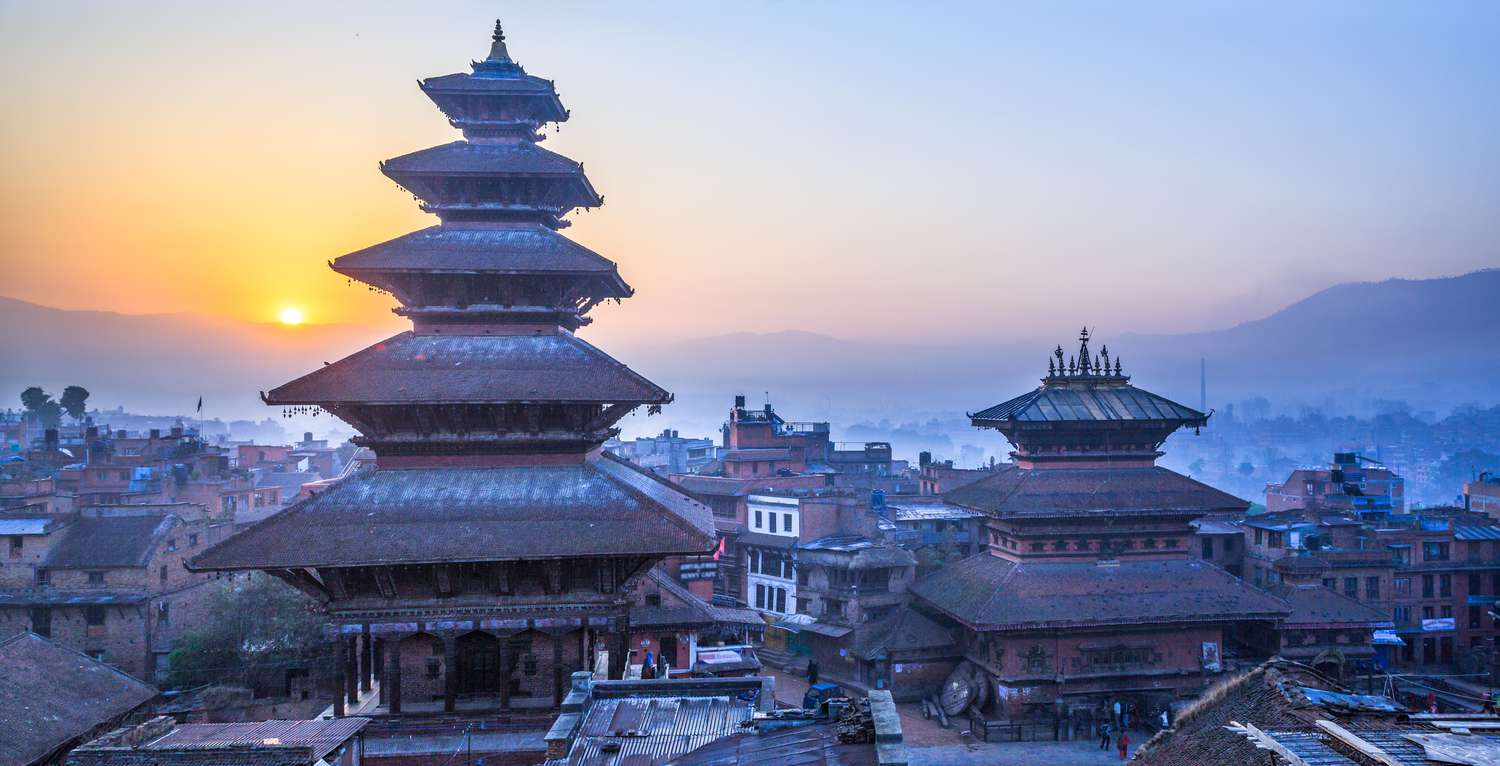The greatest adjective to describe Nepal’s architecture is majestic. In addition to its spectacular scenery, Nepal’s complex art and architecture awe visitors from all over the world who come to see the splendor of the Ancient Land of the Gods. The artwork’s splendor is a testament to the skill of the legendary Nepalese artisans known as “Newars,” who are still in charge of maintaining its splendor. The diverse architecture of Nepal, which is frequently referred to as the “country of opposites,” places it at the confluence of two great religions, namely Buddhism and Hinduism. Notwithstanding the devastating earthquake that struck Nepal in 2015, the country is still resilient, as seen by the superb abilities and exceptional caliber of work that the Newars had to offer.
Three general categories can be used to categorize Nepal’s ancient architecture:
1. The Pagoda Style
This architectural style was first developed by ancient Nepalese craftsmen, and it was only later that Nepalese craftsmen helped it spread to places like China and Tibet.
Ancient shrines and temples in Nepal were built in the pagoda style, with many roof layers organized in increasing order from top to bottom and supported by beautifully carved wooden struts. The projecting windows are distinguished by crisscross-patterned latticed architecture. Its design is thought to have started sometime around the beginning of the 13th century and was originally made of gold and alloys like brass and bronze.
2. The Stupa Style
The traditional hemispherical dome shape of monuments built in Nepal in this architectural style has a square foundation and a pyramid-like structure on top. While some stupa structures are constructed to protect the relics of Buddha and his followers, others feature exquisite carvings of Buddhist chanting or theologies on them. This style, which is thought to have been introduced by Emperor Ashoka in Nepal, is claimed to represent the five Buddhist elements of Earth, water, fire, air, and space.
3. The Shikhara Style
Shikhara, which in Sanskrit means “mountain peak,” is another example of the genius of the ancient Nepalese architects. As a result, the shape of a structure designed in the Shikhara style resembles a mountain peak or a pyramid. The exteriors of temples or monuments designed in the shikhara style are decorated with incredibly complex and exquisite artwork.
Marvels of Architecture of Nepal Based on the Above Styles are :
1. The Pashupatinath Temple
This sacred building, which is thought to be one of Kathmandu’s oldest Hindu temples, was refurbished in the 13th century by Ananta Malla, a member of the Malla dynasty. It was rebuilt once more in the 17th century with superb artwork and as many as 492 temples along the main temple after suffering additional damage.
One of the most sacred sites for followers of Lord Shiva, this temple boasts a twin roof constructed entirely of gold and copper that supports exquisitely carved wooden rafters. The temple includes four major silver-sheeted doorways, or “dwars,” and a golden pinnacle, or “gajur,” on top. There are two sections to the total complex. While the outer complex is an open courtyard, the inner complex houses the idol for worship. This temple is one of the best examples of Nepalese pagoda building because of its high craftsmanship. The Pashupati temple complex, one of the seven UNESCO World Heritage Sites in the Kathmandu Valley, is situated on the banks of the river Bagmati.
2. Kathmandu Durbar Square
A plaza or a location close to the “durbar,” or palace, is referred to as “durbar square” in general. There are three durbar squares in Nepal, with the Kathmandu Durbar Square being the most well-known. This location, also known as Hanuman Dhoka Plaza, was once the courtyard of the Royal Palace, where the kings were installed. This quadrilateral was built in the distant past during the Licchavi dynasty, but it underwent numerous restorations while the Mallas were in power. This durbar plaza, a UNESCO World Heritage site, is home to a number of historic temples and museums, all of which have many rooftops, a hallmark of Nepal’s pagoda architectural style.
This location demonstrates the extraordinary talent that the Newari culture possessed with its various colorful engravings and beautiful artwork. Taleju, the Kasthamandap Temples, the Krishna Temple, and other well-known monuments are among of the famous temples in the Durbar Square.
3. Patan Durbar Square
The Patan Durbar Square, another Durbar square in the Kathmandu Valley, is thought to be one of the most well-known tourist destinations in Nepal. Although the origins of this Plaza are unknown, the majority of the substantial improvements are thought to have been undertaken by the Malla kings.The area is split into two sections by around 130 “bahal” courtyards and 55 significant temples. Inside the Durbar square’s inner complex are the historic royal palaces. The numerous pagoda-shaped temples in the outer complex, many of which have elaborate artwork and more than two layers of roof, are evidence of the Newars’ extraordinary artistic prowess.
One of the outstanding examples of Newar architecture may be found in the square’s center, where a distinctive Hanuman idol stands guard over the palace. This is one of the most exquisite creations of the Newars, featuring idols of many Hindu legendary gods and goddesses, including Lord Shiva, Goddess Parvati, and Lord Krishna. In 1979, UNESCO designated the Patan Dubar Plaza as a World Historic Site.
4. Bhaktapur Durbar Square
One of the three durbars in the Kathmandu valley, Bhaktapur Durbar Square, perfectly captures the diverse cultural history of Nepal, particularly the Newari community. During the Malla era in the 17th century, King Bhupatindra Malla constructed one of Nepal’s most stunning historical landmarks. It consists of various temples with multiple roofs and four squares: the Durbar Square, Taumadhi Square, Dattatreya Square, and Pottery Square. On stone plinths throughout the Durbar compound are several sculptures of historical leaders and life-size animals associated with religion. One of the primary draws of this Plaza is the fifty-five window Palace, which features a golden gate at the entry and beautiful carvings of religious texts carved on the walls.
The Vatsala Temple, Bhairavnath Temple, Nyatapola Temple, and the miniature Pashupati Temple are a few of the well-known temples in this UNESCO World Heritage Site.
5. Kasthamandap Temple
At the Hanuman Dhoka Durbar Square, there is a three-tiered temple called Kasthamandap that was built during the Malla era. Its name means “wood pavilion,” and it is thought to have been made from a single tree. It was originally used as a “mandapa,” or a pedestal for holy rituals, but was eventually transformed into a temple honoring Saint Gorakhnath. The saint Gorakhnath is reported to have joined a Machhindranath chariot parade dressed as a person until he was discovered by a “tantric,” who cursed him for a lifetime of incarceration.
This Saint Gorakhnath temple, also known as “Maru Satal,” has a highly unusual nature. His footprints have always stood in for the temple’s idol. The pinnacle, which is a crucial component of the pagoda architecture, is absent from this three-tiered pagoda temple.
6. Changu Narayan Temple
The route to Changu Narayan’s temple, which requires a number of steps to reach, passes via the charming small Nepalese village of Narayan. According to an inscription on a garuda column within the temple, the beginnings of this Hindu temple date back to the 4th century AD. This temple is devoted to Lord Vishnu, also known as “Narayana” or the age-creator.
The entire temple complex is filled with intricately carved, colorful wood statues. The dual-roofed temple, which has four ‘dwars’ or entrances and is thought to be one of Nepal’s oldest, is positioned over a high platform and is surrounded by life-size sculptures of lions and garudas. The struts holding up the temple’s roofs are inscribed with images of Lord Vishnu in many incarnations. Although being a UNESCO World Heritage Site, the Changu Narayan Temple receives very few visitors, which contributes to the tranquility of the Narayana Village.
7. Boudhanath Stupa
This Stupa, which is over 1500 years old and one of Nepal’s most revered Buddhist sanctuaries, draws a sizable following from people of all faiths, especially Buddhism. According to legend, Songtsen Gampo, a Tibetan Ruler, constructed it after accidentally killing his father. It is one of the seven UNESCO World Heritage Sites in Nepal, and it is about 118 feet tall. It has a huge hemispherical white dome with a golden pinnacle and painted eyes on all four sides. Every part of this architectural marvel has a special significance.
The stupa’s apex symbolizes Mount Sumera, the center of the spiritual universes and what is said to be the residence of the gods. The thirteen steps of the stupa stand in for the path to enlightenment, or “Bodhi,” while the gilded canopy represents air. The nose, painted right below the eyes, denotes unity and the sole path to ‘bodhi,’ or spiritual enlightenment. A pair of eyes, painted on all sides of the central tower, symbolizes the all-knowing nature of Lord Buddha. The stupa’s hemispherical dome symbolizes the cosmos. The hemispherical dome is supported by two circular plinths that represent water.
8. Swayambhunath Stupa
This stupa, one of Nepal’s more magnificent architectural wonders, is regarded as the most potent shrine for Buddhist pilgrimage. The word “self-made” is swayambhunath. In order to reach the stupa’s peak, devoted pilgrims must climb 365 stairs located in the Kathmandu valley. A well-known folktale states that the valley was originally a vast lake where a lotus flower flourished. After the water dried up, the lotus evolved into the revered Swayambhunath stupa.
The Swayambhunath Stupa, also known as the “Monkey Temple,” has a white hemispherical dome that symbolizes the earth and 13 tiers that represent the various phases that one must go through to reach spiritual enlightenment or Nirvana. It contains three painted eyes on each side; the first two, known as the “all-seeing eyes,” represent Lord Buddha’s omnipresence, while the third eye represents wisdom. The nose’s wavy question mark form represents harmony.




